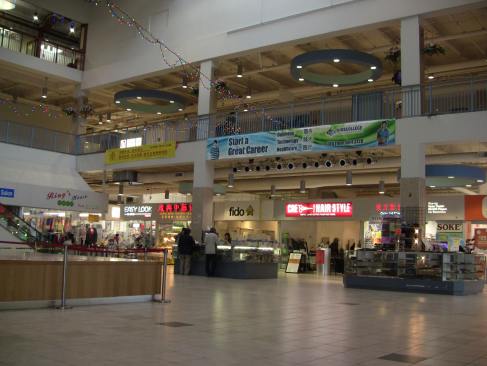Located inside the Agincourt area, the intersection between Brimley Road and Sheppard Av. East is in constant movement. Markets, unified by strong ethnic backgrounds, converge to form a community and manage to create a generally peaceful and harmonious neighborhood. This defined essence of a different tradition and culture, however, can make feel a new neighbor stranded. These two case studies reveal what happens when cultures clash in such a small and confined space.
This map its meant to represent the area covered in these two stories.
Language Barrier
A combination of Chinese-based dialects is spoken as a home language by 43.8% of the total of the population of Agincourt according to Statistics Canada, 2006. In the Brimley and Sheppard area, it is not difficult to notice the huge influx of Chinese-born immigrants living and working and studying here.
Tracy Liang is an 18 year old college student. She was born In China and came to Canada when she was 15 along with her family. She is now living with her sister near Brimley and Sheppard in a small Chinese suburb.
“Most people speak Cantonese so it is not difficult,” Liang said referring to the number of Chinese immigrants living in the area. “Everything has Chinese and English; It’s a good place to live,” she added.
Chinese evangelist, Chinese Feng Shui advisors, and Chinese acupuncturists are some of the services you can find on Brimley and Sheppard alone along with the more traditional Immigration counselling, travel agencies, and restaurants. However, because everything is so Chinese-centred, mistranslations and communication problems tend to arise.
Linda Yang is an acupuncturist working in the Oriental Centre, the biggest. Nailed to the front wall of her small office in the building there is a business card holder filled with a deck of white cards. Written in a dark blue font are her achievements and credentials, her cell-phone number, and the address of her office; all of this in both a Chinese and English versions split in two by a thin line of blue ink.
Yang, an immigrant from China, recognizes that a lot of problems can come when the language barrier appears. “It’s difficult sometimes to understand and be confident about your English,” she says.
A Chinese restaurant called Boston Steak House located around the area, had some similar understanding problems when I tried to interview them for another project around two weeks ago.
Despite, or maybe because of the locale being very small, it felt elegant. The near twelve circular tables were pretty much empty at around 4:00 p.m. The owner, a Chinese immigrant, spoke to me. She seemed to be very happy trying to answer my questions. However, it took me around 10 to 15 minutes to explain exactly what I was trying to do.
Copyright Infringement
Within the enclosed space of the Oriental Centre there are around 10 different DVD stores representing something close to 30% percent of the total commercial activity in the first two floors. All of these DVD stores sell counterfeit material.
For years, the often visited Chinese and Philippine mall has had cheap, pirated DVDs as one of their more recognizable staples; however, this lucrative business was also the root to many problems. Back in the late 2010 and early 2011, police raids ending in arrests and seizures of thousands of copyright-infringing material were often seen by the general public. These raids tended to happen frequently until this year when they started fading out.
Loraine Yen is the clerk of one DVD store inside the Oriental Centre. Outside her shop, poster signs for Philippine movies cover the glass walls and fill it up with bright and blinding colours. DVD covers are also set outside, meticulously arranged on a white table with some possessing small post-it notes stuck on the edge signaling whether the film is “new” or “comedy,” or some other film genre.
Yen attributes the police raids to the past sale of pirated Hollywood films. “That was for the English movies,” she says, “we only sell Philippine and Chinese movies.”
Even though it is true that most of the DVD retailers focus on Asian movies, it’s difficult to know whether the counterfeit market for Hollywood films still exists. Yen, when asked whether there were still shops selling these films said that she “could not tell.”
A closer look inside some of the stores will reveal that there are still some remains of the Oriental Centre’s past. Hidden in plain sight, bootlegged music albums from popular western bands like ABBA, The Bee Gees or even The Wailers, show up. Documentaries by networks like the BBC or National Geographic also appear under the huge piles of cataloged DVD covers in some other stores.

